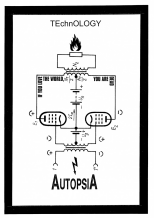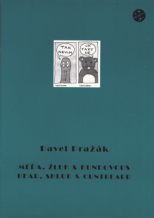| Revista Umělec 2005/2 >> Maix Mayer | Lista de todas las ediciones | ||||||||||||
|
|||||||||||||
Maix MayerRevista Umělec 2005/201.02.2005 Martin Vančát | Entrevista | en cs de |
|||||||||||||
|
We paused on our night stroll through the city to gaze at a model of an airplane in an illuminated window of an airline office. It was propped inconspicuously on a thin metal rod among advertisements and flowerpots, in an arrangement that hadn’t been altered much since the 1970s. Airline companies have borrowed these elements from each other to demonstrate that their machines really do fly through the air. It is in this space that Maix Mayer moves. Drawn to situations where meaning can be freely transmuted, the range of his artistic interest is thus mostly in creating a relation to reality and in its description. He often finds inspiration in architecture and film.
Hippies? When Maix Mayer was born in Leipzig, people in East Germany still believed in a better future; they gave their children fantastic names, confident that they represented a generation that would take business trips in space. The space program started and it entered everyone’s lives. In the West, cinemas were haunted by the Countess of Spessart, and the Nürnberg – Stuttgart autobahn was being built. There was so much going on, and people weren’t entirely sure whether this was not a dream. Little Maix was a perceptive child. He took it all in and attempted to escape into the world of marine biology. This was supposedly to eventually obtain the opportunity to journey around the world. We often say “I would have liked to have experienced that era!” but we never really mean it, unless we would first be able to negotiate some really good conditions for ourselves. Be careful, this is the DDR in year one! As a child he visited the Leipzig Trade Fair where he saw unbelievable prototypes of garden huts. He and his friends also saw the movie Der schweigende Stern, the first of four sci-fi films produced in East Germany. It was also distributed in the US in a cut and censored version, entitled First Spaceship on Venus. The film engraved in his memory the acting of Oldřich Lukeš, a star from the Czechoslovak TV series We from the End of the World (My z konce světa), and the character of a Chinese linguist speaking with stars on Venus. Subfiction Many years later Mayer created his Subfiction series. Subfiction I (2000), which was to be followed by three sequels, has clear conceptual features. Mayer became acquainted with the scenographer of the film Der schweigende Stern. She told him specific details about the shooting of the film, but he was most intrigued by the character of the Chinese linguist. Because the Chinese actor for the role, Tang Hua-Ta, was unable to utter a single German word, his dialog had to be dubbed in later – but he speaks continuously throughout the film. Mayer opted to take it a bit further. He traveled to Hong Kong in search of someone who could read lips. No easy task, he ultimately learned that the Chinese actor had been confessing his love to a Japanese actress who also performed in the movie. The entire process of investigation is documented in Subfiction 2 (2000) for which Mayer had an original film poster created. During his sojourn in Hong Kong he hired some old-school poster painters to paint a Chinese scientist inside a rocket flying through space. The subject of Mayer’s work is the process of filming a 40 year-old movie, into which he intervenes as an obsessed private eye – and which he manages to shift from the original time and place. As a reward for the effort, he managed to make the insignificance of the value of information and memory relevant. Subfiction continues with episodes 3 and 4 (2001). For the first part, he sent the portrait of the enamored Chinese linguist into space in his favorite object: the garden house he had seen for the first time years previously at the Leipzig Trade Fair. Agreed that the subject of the last two episodes would be space, Mayer decided to employ 3D animation. Whereas in episode 3, there is a cheerful spacetrip with references to elementary chemical nomenclature, part 4 is inspired by the final scene in Antonioni’s masterpiece Zabriskie Point—the explosion of the villa. The garden hut falls apart in a pathetically existential atmosphere into small parts as it might on the day of reckoning; but in Mayer’s version the soundtrack isn’t Pink Floyd, but instead Albert Einstein himself playing the violin. The piece is called Theory of Relativity. In this work Mayer managed to reveal the technical principles of the composition of the most famous scene from Antonioni’s movie, simultaneously paraphrasing it with elegance in his own work. He substitutes Antonioni’s 17 cameras using 3D animation. The flash of the explosion in the new image can hardly be incorporated into some known time and special frame. While watching the slow disintegration of the whole into single parts, we unknowingly transgress the boundary separating the concrete from the abstract picture. Obsession with Concrete Ardent about the architecture that grew up alongside him in East Germany, Mayer acquired a neutral attitude, returning to it regularly. In his first movie, called Transarchitecture or Psycho in Dresden (1997), he captures the city’s architectonic details, attempting to articulate the emptiness engendered so miraculously. With elegant simplicity, he reveals how architecture silently controls the city’s inhabitants. Perverse and non-descriptive, the film alternates scenes from different places with abstract lines in a structure appropriate for such a kind of storytelling. In a project called Hanoi (2004) he produced ten large-format prints that present the current condition of Halle-Neustadt, which was built after World War II. These pictures can be read as portraits of the power of communist architecture—audacious experiments with urbanism. Because they would disturb the perfection of architecture, people are entirely absent. Included with the Hanoi exhibition was a model of Kugelhaus, a bizarre round building consisting of 20 hexagons and 12 pentagons, standing on five supports. In East Germany this building’s design ensured that a building permit wouldn’t be required. The Hanoi installation was completed by two chairs from which to gaze out into the street. The chairs had headphones in which people could listen to imaginary conversations somewhere in the streets. Last Train to Trancentral Mayer’s regard towards railways is not unlike his affinity with architecture. Last year’s project Zum um Zug (Step by Step/ Train by Train) was presented at the Leipzig railway station depot. His documentary, accompanied by the normal activities of the railroad station, was projected on a screen set up on the locomotive switching turntable. The film is about fascination with railroads, an obsession deeply rooted in the German psyche. Toyshops in Germany are full of them. Czech children must have wondered why East Germans liked building cities and railway models so much. Mayer recorded interviews with people who take pictures of locomotives or build new railways for model trains in their free time. He investigated the nature of escaping from reality with the help of a hobby. Recently Mayer has been working with British DJ Robin Rimbaud, aka Scanner. The Transrapid mix is a free DJ/VJ performance for which Mayer projects images and Scanner plays techno. It starts with a monotone sequence with a wagon that Mayer continuously inter-cuts with ten other movies that feature trains sequences. This ‘unity of place’ is basic and functional and quite typical for his work. He very gently draws us into the story whose pace increases constantly, culminating with a massive train accident involving all the trains in the world. A Journey Into Space Mayer’s last film is called Raumgleiter. In a certain view it exploits other sources of his previous work but returns to the typical elements of his inwardly driven works. Mayer seized the opportunity to film in the still-closed Leipzig Museum of Modern and Contemporary Art. He made precise, slow scenes, in which the camera moves through space and creates an illusion of a generated 3D space. The importance of modernist geometrical abstraction on the architecture is rendered apparent. Mondrian and Malevich look at us from every opening, although nobody has seen them in the building yet. Space thus becomes unconcrete and neutral—something that can be perceived from different angles, inverted, a place from which we can flee at the speed of light. But it also becomes an index of its own esthetic determination. One particularly fantastic scene is in the depository and engine room. One can sense the perfect harmony of the metaphorical junction collection of contemporary art – spaceship. Whereas upstairs, one is touched by the beauty and functionality, downstairs everything is oily, and the machines never stop. And Then... Maix Mayer has refined his abstract expression with film and 3D animation. Working with information liberally yet responsibly, he considers it an incidental secret code to be decifered and encoded further. He doesn’t force any concrete meanings upon us, but seeks out levels of their collective sharing. He likes to work with one distinct object, repeatedly transforming it to alter potential levels of meaning. It is as if he showed that it’s model situations he cares about, which we can fill whatever occurs to us into. The narrative is secondary to the way the poetics of the images are grounded among the signifiers of the world we ourselves are largely a part of.
01.02.2005
Artículos recomendados
|
|||||||||||||
|
04.02.2020 10:17
Letošní 50. ročník Art Basel přilákal celkem 93 000 návštěvníků a sběratelů z 80 zemí světa. 290 prémiových galerií představilo umělecká díla od počátku 20. století až po současnost. Hlavní sektor přehlídky, tradičně v prvním patře výstavního prostoru, představil 232 předních galerií z celého světa nabízející umění nejvyšší kvality. Veletrh ukázal vzestupný trend prodeje prostřednictvím galerií jak soukromým sbírkám, tak i institucím. Kromě hlavního veletrhu stály za návštěvu i ty přidružené: Volta, Liste a Photo Basel, k tomu doprovodné programy a výstavy v místních institucích, které kvalitou daleko přesahují hranice města tj. Kunsthalle Basel, Kunstmuseum, Tinguely muzeum nebo Fondation Beyeler.
|













































 We Are Rising National Gallery For You! Go to Kyjov by Krásná Lípa no.37.
We Are Rising National Gallery For You! Go to Kyjov by Krásná Lípa no.37.
Comentarios
Actualmente no hay comentariosAgregar nuevo comentario